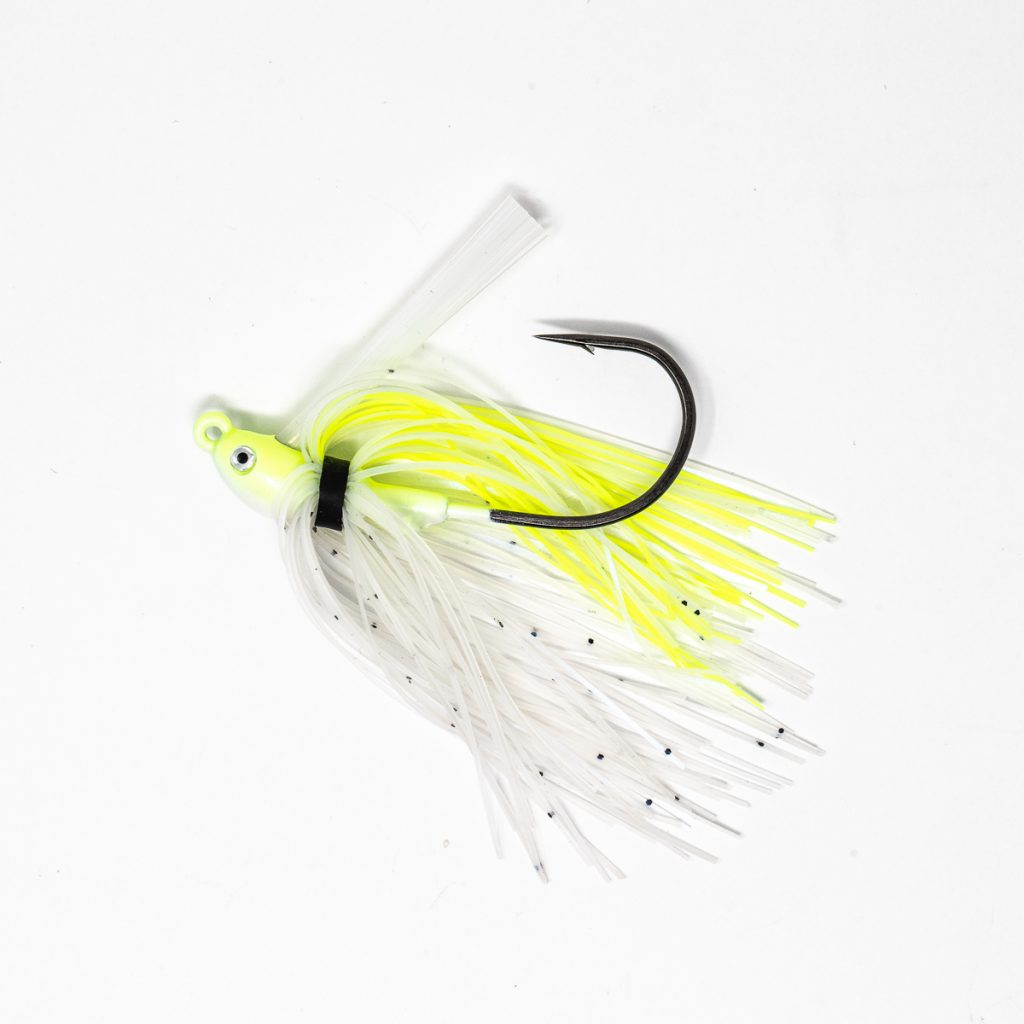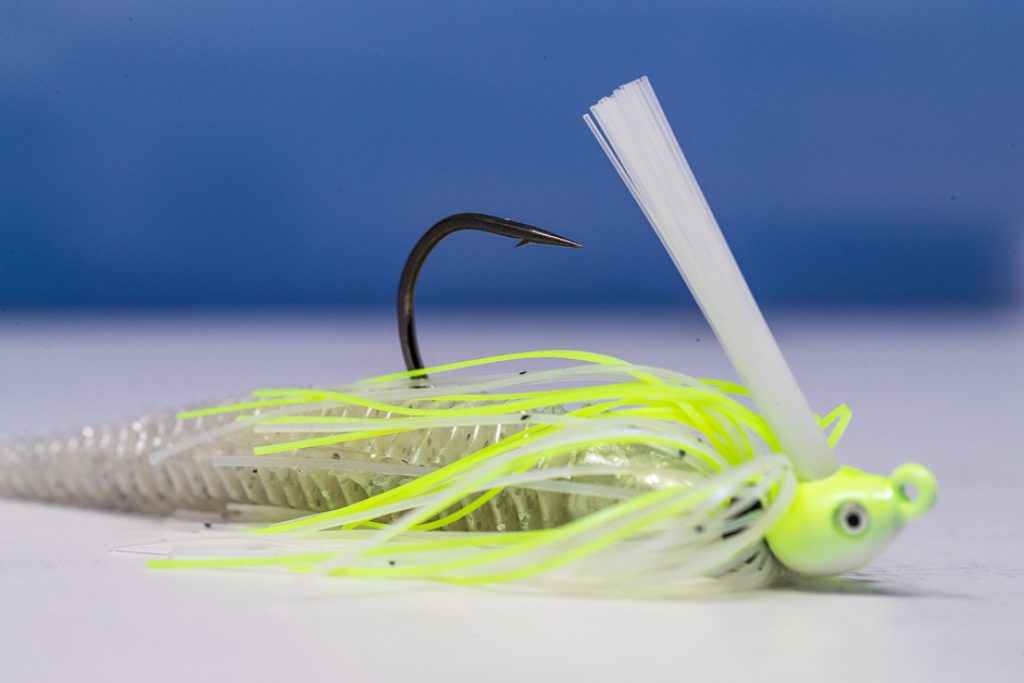For bass fishermen and fisherwomen across the United States, finding the right lures and baits is an essential part of the pre-trip preparations. While the best setups will include various options, swim jigs for bass fishing are one solution that should feature in every angler’s arsenal.
Whether you’re a complete novice or an experienced angler looking at swim jigs for bass fishing, this guide will answer the following key questions:
- What are swim jigs?
- Which swim jigs are best for bass fishing?
- When should swim jigs be used?
- How can you fish with swim jigs for bass fishing?
- What else should be included in the bass fishing setup?
If you want to become a more proficient angler, cast your eyes on the info before.
What are Swim Jigs?
Like all jigs, swim jigs for bass fishing are a type of lure that is commonly used by fishermen and fisherwomen across the United States and beyond. This type of bait was popularized during the 1980s and has remained a mainstay for professional anglers, as well as thousands of novices.
Swim jigs are differentiated from other jigs by the characteristics of their head. A swim jig has a pointed nose while their weight is distributed heavily to the bottom of the jig, thus allowing for a smooth and upright swim during retrieval. A vertical line tie promotes a smoother movement through the cover and the entire water column.
It could easily be argued that swim jigs are the most versatile option for bass fishing as they can be used at various depths After all, they can be retrieved with a fast reel, slow reel, and through a choice of hard-bottomed areas and heavily vegetated spaces alike. Crucially, they are easy to use and extremely efficient, making them a great choice for all fishermen and women of varying experience levels.
Swim jigs also feature a skirt, much like other jigs you may have used or seen. They may be made from a range of plastics or silicones, in addition to a wide range of colors, which are capable of engaging predatory fish that are attracted to the appearance, movement, and water disturbance.
As the swim jigs move through the water, the skirt helps mask the hooks. But as soon as a bass (or other predatory fish) strikes, they are very efficient.
Best Swim Jigs Setup
Using swim jigs creates a versatile setup that allows you to fish in a variety of methods, but only when they are matched to the right rods, reels, and lines.
Choosing the right rod for swim jigs
When selecting a rod for bass fishing with swim jigs, there are two key components to consider. The length and the power. A medium-heavy action rod is probably required due to the weight of the jigs while this also supports you through the striking action as well as the ensuing fight.
Whichever technique is used (they’re shown below), you will find that getting good length on the cast is a key ingredient for successful swim jig bass fishing.
Choosing the right reel for swim jigs
The right reel for bass fishing with swim jigs will be determined primarily by which retrieval technique is used. If opting for a slow and smooth action, a 6.1:1 ratio is the maximum you should be prepared to use. Conversely, if using a fast action, you will seek a ratio that is no lower than 7.1:1 and probably higher.
Whether it’s a high-speed baitcasting reel or a low-speed baitcasting option, a deep spool should help as you seek those long casts.
Choosing the right line for swim jigs
The lures are relatively heavy, so you need a line that has strength and durability. In most cases, either a 50lb braid line or a 20lb fluorocarbon line will suffice. It is largely a personal preference, although you will want to check that it works well with the rod and reel. Also, if you are using a swim and kill approach (see below), you may find that the fluorocarbon is kinder to your fingers.
If the line is too weak, it’ll snap as soon as you get a bite. Too heavy, and your bass fishing techniques will be limited.
How to Fish Swim Jigs
Swim jigs are extremely versatile, perhaps even more so than other popular jig types. Therefore, you may find yourself deploying a variety of retrieval techniques over the course of a day due to the settings at any given time. Three of the most popular methods are listed below:
Swim & kill
One of the most popular methods, which can also be used by some of the alternative jigs on the market, is the swim and kill (also known as bomb and drag. This retrieval technique works on the basic idea that you drag it for a short distance before letting it come to a stop for a few seconds and repeating the process until a strike occurs.
A long cast is preferred as it will give you more room to ‘swim’ in. Let the jig sink to the lake bed before reeling it with a smooth motion for a couple of meters. Then kill it, and start the process again by pulling the slackline and using a vertical lift. Be prepared for bass bites during the swim or the kill phases.
Surface swimming
Surface swimming is pretty self-explanatory. You will swim the jig across the top of the water and vegetation, rarely dropping any lower than 1” below the surface. This is achieved by using a fast retrieval technique, which is why a long cast is needed once. You should start reeling as soon as the lure hits the water.
The water ripples and surface disruptions will attract bass that are near the surface, giving you a good strike zone. You will want to avoid bouncing your swim jig out of the water. Meanwhile, keeping the rod tip low and using a sideways strike will aid your efficiency.
Subsurface swimming
Fishing below the surface is another popular method. The depth will be somewhere between the two alternative methods mentioned above, although probably closer to the surface. Even so, fishing in the shallow waters will allow for a choice of a fast or slow retrieval to attract bites from nearby bass.
Once again, a long cast gives you the best starting point, which is why the choice of rod is so significant. Whether using a fast or slow reel, a smooth retrieval will see the swim jigs’ skirt create the desired level of visibility and movement. Keep the rod tip pointed low and use a medium-power strike.
When to Use Swim Jigs
Swim jigs aren’t only versatile in the fact they can be used on the surface, below the surface, or on the lake bed. The positioning of the swim jig’s eyelet helps avoid any threat of snagging against weeds, thus opening the potential for fishing in weeded areas. So, you can use them for open spaces and in tight areas.
When there’s a lot of cover, you may wish to choose a swimbait-style trailer due to help prevent snagging. In the open areas, the standard craw-style trailers and skirts are ideal.
Although the swim jig can be used in any season, spring is a perfect time for using it. Bass are actively moving off the beds and this lure will give you a great strike zone. Professional fishermen and women often bring out this solution during the spring and early summer.
All-weather conditions are suitable, although you will want to avoid surface swimming if the waters are dirty and muddy. It can be a great option after rainfall, though. Tellingly, if you find that a method is working on a particular day, you should stick with it.
Finally, whatever the setting, swim jigs should be matched to the dominant forage. If the lure fails to stand out, any strategies you employ will be rendered redundant.
Best Swim Jigs
Swim jigs have been frequently used for several decades now. As such, there are plenty of fantastic options on the market. Here are five purchases that you should consider for your setup.
RUNCL Swim Jigs
RUNCL offers a wide range of jigs across various styles, and their swim jigs are among the best on the market. The fish-shaped head and 3D eyes will attract predators, which is helped by the 100-strand silicone skirt. With four highly effective colors, you’ll be ready for many settings.
Lunkerhunt Natural Skirted Swim Jigs
Designed to replicate the look of freshwater baitfish but also having a wire-tied skirt and nylon weed guard, the simple device by Lunkerhunt features a 60-degree hook. It strikes the right balance between avoid weeds and leaving the hook unimpeded.
Nicholas Lures Saber Swim Jig
The 3/8oz Nicholas Lures swim jig has a fish-shaped head that has 3D eyes and is painted with a flake finish to attract bass in the water. At 4” long and with a 30-degree line tie position, it is a very practical solution for all retrieval techniques. It also has a sharp mustard hook.
Reaction Tackle Tungsten Swim Jigs
The dual pack of tungsten swim jigs offer a great solution when looking for a light (0.5oz) and sensitive solution that will respond to even the lightest of reeling action. This makes them a great option for navigating cover. A choice of skirt colors helps too.
Croch Bass Jigs Set
The Croch Bass 20-piece jigs set isn’t limited to swim jigs and has options for skipping and flipping. However, with 10 unique 50-strand silicone skirts, including contrasting color schemes, you will find a suitable choice. The anti-snagging attributes of the weed guard are very effective.














